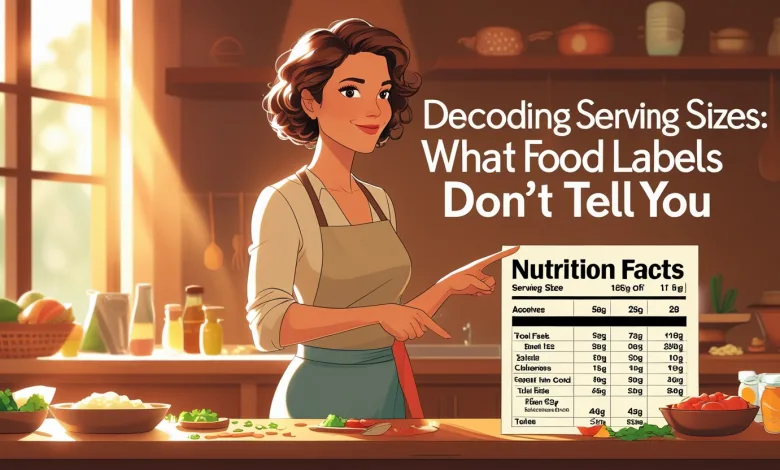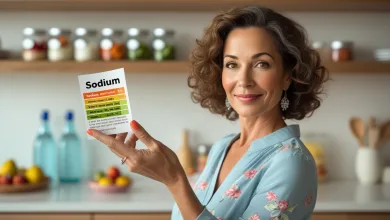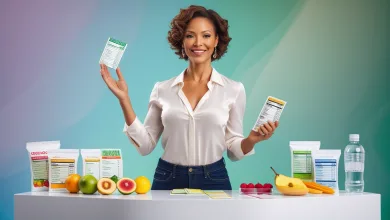Decoding Serving Sizes: What Food Labels Don’t Tell You

Ever grabbed a “single-serving” bag of chips only to discover it supposedly contains 2.5 servings? You’re not alone. Food label serving sizes often confuse consumers and can significantly impact our perception of what we’re eating. Let’s pull back the curtain on this deceptive practice and learn how to become savvier shoppers.
The Serving Size Shell Game: How Manufacturers Manipulate the Numbers
Let’s face it — food labels can be downright confusing. You pick up what looks like a single-portion snack, flip it over to check the calories, and suddenly realize you’re holding something that’s supposedly multiple servings. Wait, what? Who eats just a third of a muffin or half a can of soup?
This confusion isn’t accidental. Many food manufacturers have historically used serving sizes as a clever marketing tool. By breaking products into unrealistically small portions, they can advertise lower calories, sugar, and fat content per “serving” — even when most consumers eat the entire package in one sitting. It’s a nutritional sleight of hand that’s been going on for decades, and it’s definitely not doing our waistlines any favors.
According to research from the Journal of the Academy of Nutrition and Dietetics, people consistently underestimate how much they’re eating by 20-40% when relying on package serving sizes as their guide. That’s a significant difference that can add up to hundreds of unexpected calories per day!
The Evolution of Serving Size Regulations: Past, Present, and Future
Serving sizes weren’t always this misleading. When nutrition labeling was first standardized in the early 1990s, the FDA based serving sizes on surveys of what Americans typically consumed in one sitting — called “Reference Amounts Customarily Consumed” (RACCs).
But here’s the kicker: those original measurements were based on eating habits from the 1970s and 80s. Yikes! Since then, portion sizes in America have grown dramatically. The average restaurant meal is now four times larger than it was in the 1950s, and the size of an average dinner plate has increased by nearly 23% since the 1900s.
In 2016, the FDA finally recognized this disconnect and updated serving size regulations for the first time in over two decades. The new rules require manufacturers to list serving sizes that more closely reflect what people actually eat, not what they should eat. That’s why you might have noticed some calorie counts seemingly increase overnight on certain products — the serving sizes became more realistic.
However, implementation has been gradual, and many products still feature outdated or misleading portions. Plus, manufacturers continually find creative ways to present their nutritional information in the most flattering light possible.
Decoding Serving Sizes: Common Tricks to Watch For
When it comes to deciphering food labels, knowledge is power. Here are some of the sneakiest serving size tricks manufacturers use to make their products appear healthier than they actually are:
The “Who Eats That Little?” Technique
This is perhaps the most common serving size deception. Examples include:
- Listing a serving of cereal as 3/4 cup when most people pour at least twice that amount
- Showing a serving of ice cream as 1/2 cup (about the size of a tennis ball) when the average scoop is closer to 1 cup
- Splitting a standard 20 oz bottle of soda into 2.5 servings, even though most people drink the entire bottle
Research from the University of Liverpool found that consumers consistently serve themselves portions 20-40% larger than the serving sizes listed on package labels. No wonder we’re confused!
The “Dual Column” Confusion
Some manufacturers have responded to new regulations by including dual columns on their nutrition facts — one for a single serving and one for the entire package. While seemingly helpful, this can actually create more confusion as consumers struggle to determine which column applies to their eating habits.
“When presented with multiple sets of nutritional information, many consumers simply default to the lower numbers,” explains Dr. Marion Nestle, Professor of Nutrition at New York University. “It’s cognitive overload that often leads to dismissing the information entirely.”
The “Hidden Math Problem”
Ever notice how some products list oddly specific serving sizes like 2/3 cup or 27 grams? This requires consumers to do mental math to figure out what they’re actually consuming. Studies show that these calculations are particularly challenging for many Americans — a 2018 survey by the International Food Information Council found that 59% of consumers report difficulty understanding quantitative information on food labels.
How Serving Sizes Impact Your Health Goals
The disconnect between labeled serving sizes and what we actually eat has real consequences for our health. When we consistently underestimate our consumption, we may wonder why weight loss efforts stall or why blood sugar levels remain elevated despite “careful” eating.
Consider this real-world example: A typical 16 oz bag of tortilla chips might list a serving size as 1 ounce (about 15 chips), containing 150 calories. That seems reasonable… until you realize the entire bag contains 16 servings, totaling 2,400 calories! Many people might mindlessly eat half the bag while watching a movie, consuming 1,200 calories without realizing it.
This disconnect affects not just weight management but also our overall relationship with food. When nutritional information feels deceptive or confusing, many consumers develop label fatigue and stop paying attention altogether. According to nutrition psychologist Dr. Brian Wansink, “Once people feel misled by food labels, they tend to disregard them entirely, which can lead to even poorer dietary choices.”
Reading Between the Lines: Becoming a Serving Size Detective
So how can you cut through the confusion and become a more informed consumer? Here are some practical strategies:
Measure It Once to See the Reality
Take your favorite foods and actually measure out the suggested serving size. Pour that 3/4 cup of cereal or count out those 15 chips. You’ll likely be surprised at how small the suggested portion appears compared to what you typically eat.
This isn’t about judgment — it’s about awareness. Once you know what an actual serving looks like, you can make informed decisions about how much you choose to eat. Maybe one serving is enough, or perhaps you’ll decide to enjoy two or three and adjust the rest of your day accordingly.
Focus on Per-100g Comparisons
When comparing products, look at the nutritional information per 100 grams rather than per serving. Since serving sizes can vary dramatically between similar products, this standardized measurement gives you a more accurate basis for comparison.
“The 100-gram comparison method is what nutritionists use to cut through marketing noise,” explains registered dietitian Lisa Young, PhD, author of “Finally Full, Finally Slim.” “It levels the playing field between products and gives you a true sense of the nutritional density.”
Understand the Container Effect
Research shows that we tend to consume more from larger packages, regardless of hunger levels. This phenomenon, known as the “container effect,” means that products packaged as single units (like bottles, bags, or boxes) are typically consumed in one sitting regardless of the stated number of servings.
“Our brains are wired to use visual cues like empty containers to signal when we should stop eating, rather than internal fullness cues,” explains Dr. Wansink. “This makes package size a stronger determinant of consumption than serving size labels.”
Special Considerations for Special Diets
For those with specific dietary requirements, serving size confusion can have even more significant implications:
Diabetic Considerations
For people managing diabetes, accurate carbohydrate counting is essential for proper insulin dosing. When serving sizes are misleading, blood sugar management becomes more challenging. Always calculate the total carbohydrates in the portion you actually consume, not just what the label suggests as a single serving.
The American Diabetes Association recommends using a food scale for the most accurate measurements, especially for carbohydrate-dense foods like pasta, rice, and cereal.
Low-Sodium Diets
For those monitoring sodium intake due to hypertension or heart failure, underestimating portions can lead to dangerous levels of sodium consumption. Many processed foods contain over 20% of the daily recommended sodium limit in just one serving. If you consume multiple servings, you could easily exceed your entire day’s allotment without realizing it.
Weight Management Programs
Many weight loss programs use portion control as a key strategy. When food labels misrepresent serving sizes, calorie counting becomes inaccurate. This can be particularly frustrating for those carefully tracking intake who may not understand why they’re not seeing expected results.
The Future of Food Labeling: What’s Changing?
The good news is that both regulations and consumer awareness continue to evolve. Here’s what we’re seeing on the horizon:
Clearer Visual Guides
Some countries have implemented more intuitive labeling systems. For example, the UK’s “traffic light” system uses red, yellow, and green color-coding to indicate whether products are high, medium, or low in fat, sugar, and salt. This helps consumers make quick visual assessments without needing to calculate serving sizes.
Digital Solutions
Several smartphone apps now allow consumers to scan barcodes and see nutritional information recalculated for custom serving sizes. This technology helps bridge the gap between labeled information and actual consumption habits.
Consumer Education Initiatives
Organizations such as the Academy of Nutrition and Dietetics have increased their focus on consumer education around food labeling. Their resources help shoppers understand how to interpret nutrition information more accurately.
Frequently Asked Questions About Serving Sizes
Why don’t serving sizes reflect what people actually eat?
While FDA regulations now require serving sizes to more closely match typical consumption patterns, many factors influence these determinations. Manufacturers must balance regulatory requirements with marketing considerations, and changes to packaging can take time to implement. Additionally, what constitutes a “typical” portion varies widely among demographics and cultures.
How can I tell if a package is meant to be a single serving?
Under current FDA guidelines, packages containing less than 200% of the reference amount customarily consumed must be labeled as a single serving. Additionally, packages that can reasonably be consumed in one sitting must provide nutritional information for the entire package. Look for phrases like “per container” or “per package” to indicate single-serving items.
Do other countries handle serving sizes differently?
Yes! The European Union, for example, requires standardized portion sizes on nutrition labels and mandates that nutritional information be provided per 100g/100ml to facilitate product comparisons. Australia and New Zealand use a similar system, while Canada’s approach more closely resembles that of the United States.
The Bottom Line: Becoming an Empowered Consumer
Decoding serving sizes on food labels doesn’t have to be complicated once you understand the system and its limitations. By developing awareness of typical serving sizes, measuring portions occasionally to maintain perspective, and focusing on the quality of your overall diet rather than obsessing over numbers, you can navigate the supermarket with confidence.
Remember that serving sizes on food labels are just one tool in your nutritional toolkit. They provide valuable information but shouldn’t be the only factor guiding your food choices. Balance, variety, and mindful eating remain the cornerstone principles of healthy nutrition.
The next time you pick up a package of your favorite snack, take a moment to check not just the calories per serving, but how many servings the package contains. That small step toward more informed consumption puts you back in control of your nutritional choices — and that’s something we can all feel good about.






